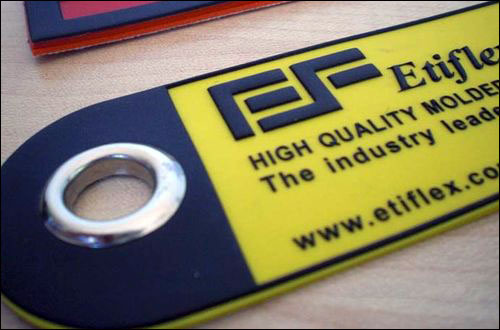Startup company TrazeTag has designed a tough, rubber passive RFID label for use in harsh environments, such as those found in construction, aerospace, manufacturing and storage-yard applications. Because the label’s RFID inlay is enclosed in a flexible, durable material, the company reports, it can survive rugged handling, physical abuse and exposure to heat and water. The label, which is commercially available now with a variety of low-frequency (LF), high-frequency (HF) or ultrahigh-frequency (UHF) passive RFID inlays, is designed to be visually readable. Unlike other RFID tags and labels that typically have text printed or painted on their surface—which has the potential of being scratched or damaged—the TrazeTag label is embossed with graphic information on the front and back, such as company logos, ID numbers or letters.
The tags are being marketed and distributed by Etiflex, the company that manufactures the rubber labels in which the RFID inlays are embedded. The two companies will demonstrate the tags at RFID Journal LIVE! 2011, to be held on Apr. 12-14, 2011, in Orlando, Fla.
This month, General Dynamics Electric Boat, which designs, builds and maintains submarines for the U.S. Navy, completed tests performed on a sampling of approximately 20 TrazeTag tags, exposing them to ultraviolet radiation, salt fog and temperatures of -80 degrees Fahrenheit (-62 degrees Celsius) for four weeks. When the tests were finished, Electric Boat reported to TrazeTag that the tags remained intact, with no signs of distortion, material degradation or crack formation. TrazeTag then evaluated the functionality of the passive HF tags’ embedded RFID inlays, and found that they could still be read effectively. According to Leandro Margulis, TrazeTag’s founder, General Dynamics Electric Boat has indicated that it could use the TrazeTag tags for tracking heavy equipment in its submarine-building operations, though no commitment has yet been made.
Margulis identified a need for the rubberized tag while working for General Electric, at the company’s locomotive production site in Erie, Pa. He noticed that the factory’s workers found it difficult to track wire cable—used by cranes to lift heavy steel items—when the staging area was filled with numerous types of cable identified only with a printed label that could, at times, be hard to read.
In some cases, Margulis says, the use of the wrong cable could be a critical mistake. Some wire ropes are designed to handle a greater amount of weight than others. To the eye, however, many wire ropes may appear the same. “I saw a need for something visual that is durable and trackable,” he states.
Later, while serving as a technology consultant at Deloitte Consulting, Margulis imagined the benefits of using radio frequency identification. “I worked with heavy-industrial manufacturers,” he says, “and saw the need to manage their equipment and materials outdoors, and in harsh environments, in an efficient way [electronically].” He found that simply having a clearly noticeable label on materials was beneficial, but that an automated system that could track the usage of material, and thus its degradation, as well as its inspection history, in a back-end server could be much more valuable.
Two years ago, Margulis formed TrazeTag to solve two problems: creating a tough RFID label for harsh environments, and, for redundancy, accommodating a visual set of information on the front and back of the label.
The company completed a prototype of the product and first tested the tags in Margulis’ home. In an effort to determine how tough the tags were, he placed them in his freezer, dropped them several stories from a window and stomped on them. Several summer interns assisted in the abuse, he says, but the tags remained undamaged.
To manufacture the tags, Etiflex employs TrazeTag’s proprietary and patent-pending process to embed RFID inlays into rubber labels shaped and colored to suit a particular user’s requirements. Durable visual aids (logos and words) are molded into the material—not painted or printed on it. Any type of passive inlay can be embedded within the tag, Margulis says. He expects that most users will encode the embedded RFID chips with simply an ID number, linked in a back-end system to information about the item being tagged. Some TrazeTag customers, however, might request an RFID inlay on which more data could be encoded, such as every time an item was used or inspected.
In one scenario, a construction company could attach the tags to cables, such as those used by cranes. Staff members would glance at the front of each label to identify a cable initially, and then use a handheld interrogator to read the tag’s inlay, thereby confirming that cable’s identity. If the cable is the correct one, an employee could then enter information into the handheld reader, indicating that the item was being used, and how, thereby enabling the firm to store an electronic record of the cable’s history. If the cable was due for inspection, the staff could be immediately alerted to that status on the handheld, as long as the site had a cellular or Wi-Fi connection. Inspectors could then utilize the handhelds in a similar manner to update information about an item’s inspections or maintenance.
A TrazeTag label can be attached to materials, such as pipes or large pieces of equipment, in multiple ways. It could be tied to an item via cord or cable, for instance, or it could be glued, stitched, heat-sealed or welded onto it.
The labels are made to order, Margulis says, and most will include an RFID tag pre-encoded with a unique ID number only, which a user can later link to data stored in a back-end server. However, he notes, Etiflex or an end user can also encode additional data to the tag if that option is requested. TrazeTag estimates a lead time of four weeks per order. This may vary, he indicates, depending on a customer’s individual specifications.



